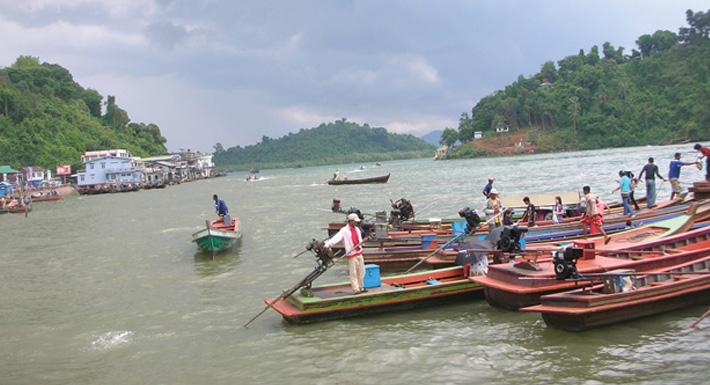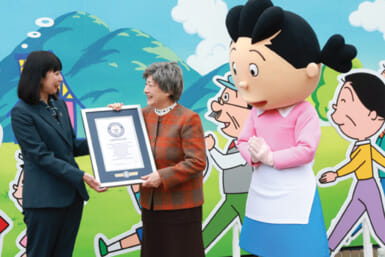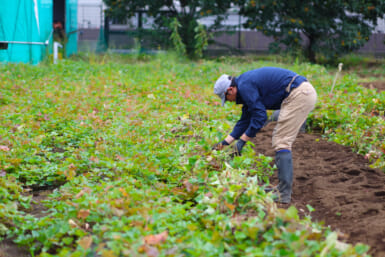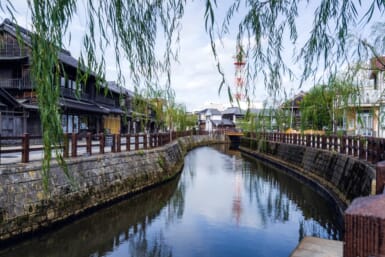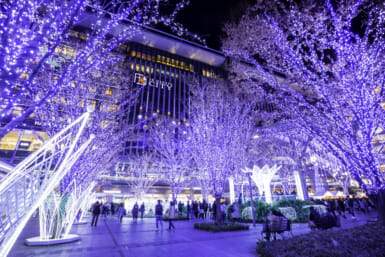While one country powers ahead to become a real player in the world markets, its close neighbor and historical rival struggles under the iron fist of an unpopular government and an apparent epidemic of narco-trafficking.
BY NICK WALKER
A year after the show-trial of Aung San Suu Kyi, that slender and gracious Burmese icon of freedom, border-crossings between Myanmar and its historical foe and present-day ASEAN ally, Thailand, are still being vigorously monitored. Except for one location.
KAWTHAUNG, Myanmar — The trip from the Thai port of Ranong across the Pagyan River Estuary to the Myanmar town of Kawthaung takes about 40 minutes by longboat, and the waterway is criss-crossed by about a dozen such vessels every hour of the day. Divided by about 15 km of water and an international maritime boundary, Ranong and Kawthaung are neighboring border towns that are both lashed by heavy monsoon rains much of the year. Traveling west from Ranong by longboat to Myanmar’s southern most town, though, is to take a journey from well-regulated and relatively prosperous modern Thailand back in time and to another world.
In the dilapidated Kawthaung, a backwater that feels like the setting for some 1940s Graham Greene novella, the colonial architecture is elegantly crumbling, dirt streets serve as the main thoroughfares, teak-boarded teahouses throng with cheerot-smoking gentlemen in longyis (heavy silk sarong), a solitary bank stands by a roundabout with the long-deserted look of a haunted house, the outdoor market displays wilting vegetables and piles of raw pork and seafood covered in flies, and young monks in orange robes reveal a modest command of English (“Hello – 50 baht?”).
Nevertheless, business is brisk though furtive, much of it of the kind that the government insists that it’s ruthlessly stamping out — ruthlessness of course being tone of the junta on most matters.
Two illegal trades are said to flourish despite denials from the new Myanmar capital of Naypyitaw: the selling and trafficking of drugs and the trafficking of people.
People-trafficking is harder to detect, but drugs are offered everywhere, notably in front of the local police station-cum-immigration office where dealers pounce readily, especially on farangs, Western-looking foreigners who usually arrive on visa runs. Drug dealers, often motorbike taxi-drivers, also sell their wares in the vicinity of Kawthaung’s rather magnificent Buddhist temple compound, which overlooks the town and an archipelago of islands that dots this part of Myanmar’s stunningly beautiful Andaman coast.
The inescapable Kawthaung vendor’s shopping list includes: “girl [sic], Viagra, ecstasy, opium, valium, ketamine, marijuana, cocaine, heroin, whatever you want …” — all quoted in baht prices, the Thai currency having supplanted the almost worthless national currency, the Kyat, which dealers won’t accept.
Kawthaung’s illicit commercial buzz supports a recent United States Department of State’s International Narcotics Control Strategy Report report, which identified Myanmar, among over 100 countries reviewed, as one of the three countries in the world that had “failed demonstrably” to crack down on the drugs trade.
Not so, say the generals heading Southeast Asia’s pariah government. According to a Myanmar Ministry of Foreign Affairs statement issued in May this year from the secretive Naypyitaw: “Myanmar has been waging a relentless war against illicit narcotic drugs for decades.”
Certainly the penalties are harsh, with 15 years or more in prison or the death penalty for drug-trafficking. But nothing is what it seems in this surreal land of devout Buddhism, politically active monks, heart-breaking limitations on the power of prayer, a tortured history, desperate poverty and a government that acts with breath-taking cynicism. The junta has enduring and complex ties with the country’s druglords, many of whom are rewarded with their own fiefdoms for their loyalty to the regime and cooperation against “dissident groups.” Moreover, international sanctions have made more legal forms of trade difficult to conduct.
Certainly the dealers in Kawthaung are fearless, possibly, of course, as they feel they have nothing to fear. With Myanmar listed as the world’s second-most corrupt country in the world after Somalia according to the Berlin-based watchdog Transparency International, official collusion in Kawthaung’s vibrant narcotics market is eminently conceivable.
The same Myanmar Ministry of Foreign Affairs statement asserts that: “At the regional level, Myanmar is working together with other members of ASEAN to reach its common goal of making the region free from drugs by 2015. Myanmar has signed a Memorandum of Understanding with six countries for the creation of a Greater Mekong Sub-Region Drug-Free Zone. Myanmar aims to rid the country of narcotic drugs by 2014, one year ahead of the date set by ASEAN.”
The military government has set itself an apparently impractical task if only on the evidence of the extent to which its busiest border-crossing has become an unashamed narco-town. Kawthaung’s remarkably diverse drugs bazaar is accessible to any visitor foolhardy enough and with a sufficient baht or dollars. In fact, according to over a dozen Western governments and international institutions of the stature of the United Nations and the International Monetary Fund, it is Myanmar’s junta who is responsible for the massive increase in drug production since 1988 and for maintaining production and exports as a means of sourcing hard currency. Not only is it believed that the junta is extensively involved in supporting and protecting the drug industry, but that the senior members are direct beneficiaries.
There can be no hope of eliminating Myanmar’s criminal drug trade until there is a return to democracy and responsible governance — and again one thinks of the gracious Aung San Suu Kyi.
But why is Kawthaung — in the deep south — so embroiled in the drug trade so far from the opium fields of the northeast? With the street touts just the visible tip of the iceberg, the town is a major nexus in the international drug trade for two main reasons. It enjoys close proximity to hundreds of mostly uninhabited islands that are perfect hiding places for caches of drugs. The complex geography and topography of the region makes it a trafficker’s dream as there are an infinite number of escape routes. Secondly, because of the volume of human traffic and the shear multitude of vessels traveling between Thailand’s Ranong and Kawthaung, policing and enforcement is impossible to comprehensively monitor.
Additionally, Kawthaung is a popular visa-run destination for farang bar-owners and other residents of the Thai tourist island of Koh Phangan and other parts of Thailand. The journey between Koh Phangan and Kawthaung involves two boat journeys on either side of the Kra Isthmus and a bus journey that crosses the isthmus at its narrowest point and takes the best part of a day. It’s a trip that many non-Thais are obliged to make every one or three months. Of course, such non-Thai nationals can choose to exit the Kingdom anywhere and to any other foreign destination by land, plane or sea.
But Kawthaung is cheap, close and convenient, and a proportion of these visa-run individuals, according to sources on the Thai side of the border, are drug purchasers.
Ancestral memories of countless wars over the centuries are strong, and it is said by some regional observers that Myanmar’s exportation of drugs across the shared border with Thailand, which snakes 1,800 km down from the Himalayas to Kawthaung, is part of a long-running strategic plan to undermine Thai society.
Finally and most obviously, Kawthaung has simply become the weakest link in the fence now that other border crossings, particularly the Three Pagodas Pass in the south of Myanmar’s Kayin State, have been tightened up by the Thai government.
A Kawthaung dealer approached this reporter, taking me for a narco-visitor, and inquired if I’d come from Koh Phangan before pressing me with offers of opium, ketamine and other substances. Not one to take no for an answer, he added with a knowing smile full of betal-stained red teeth that Koh Phangan’s infamous monthly Full Moon Party was a day away, and I could make a tidy profit if I made a purchase. This exchange took place inside the compound of Kawthaung’s Buddhist temple. Nothing is sacred it seems.
Drugs are the only goods that are thrust in the visitor’s face. There are no souvenir shops in a town that is fairly heavily touristed, albeit by visa-run visitors who usually stick around for less than an hour. Moreover, neither is there a tourist office. One can hire a motorbike-taxi up the hill to the temple, if the tropical sun makes the job of walking there seem too onerous, but chances are the driver will try a make a sale on the way.
It is difficult to gauge the extent to which Myanmar’s state-orchestrated drug trade has impoverished Kawthaung and depleted the entrepreneurial spirit in its legal sectors, but this melancholic and seedy town belongs to the rotten age of the Golden Triangle, an area that is now free of opium cultivation, at least on the Thai side of the border. Indeed one of the brands of cigarette on sale near the pier, manufactured by the state tobacco company, is branded “Golden Triangle,” as if the junta’s is thumbing its nose to the West.
As I left Myanmar, pursued by the same tout that I had met at the temple, I passed a large sign that read in the distinctive Burmese script, and under that in English: “Let us all cooperate for eradication of narcotic drugs.” Words are cheap no matter how ironic, but the trade is evidently lucrative and has likely corrupted police and immigration officials.
Back in Ranong, a town with a large Myanmar minority and a plenty of Burmese-script shop signs, various sources, including a former law enforcement officer and a guest-house proprietor, expressed a variety of views on the trade. One spoke of the “Kra Corridor,” a conduit for farangs and Thais who source drugs for Full Moon Parties and, in the case of the farangs, take care of their visa business at the same time.
Another view is that the dealers inevitably call the Thai police as soon as they’ve made a sale and provide an exact description of the buyer and which vessel the dupe is travelling back on, resulting in kickbacks all round. The picture is probably a composite of both.
In any event, the conspicuous nature of Kawthaung’s drugs trade contrasts with the government anti-drug trade statements that are usually issued for international consumption rather than to be ingested at home. An obvious though daunting priority for Myanmar should be to transparently dismantle its narco-ecomony and eradicate illegal drug exports to neighbouring states, principally Thailand. This would require the development of economic sectors to replace the hydra-headed drug trade, so that Myanmar could finally take up its place among the community of nations.
Aung San Suu Kyi, or indeed anyone but the discredited and despised junta, is going to have to wean the nation off some nasty bad habits sooner or later. In the meantime, Kawthaung remains a narcotics bazaar and transshipment point that continues to make a mockery of Myanmar’s “ruthless determination” to get its house in order.
From the “Summary” and “Corruption” sections on Burma in the United States Department of State Bureau for International Narcotics and Law Enforcement Affairs’ “International Narcotics Control Strategy Report” (2010)
Summary: “… The Government of Burma (GOB) made significant steps in poppy eradication efforts over the last decade, a period during which Burma sunk to a distant second after Afghanistan, in world poppy cultivation rankings, but it would seem the direction of cultivation and production have reversed in response to very high regional opium prices in Southeast Asia. Opium farmers are also reportedly taking advantage of efficiencies provided by improved inputs (fertilizer and irrigation systems) to increase yields. The GOB has not provided most opium farmers with access to alternative development opportunities, though UN and other international programs have had some impact. Production and export of synthetic drugs (amphetamine-type stimulants, crystal methamphetamine and Ketamine) from Burma continue unabated. Despite Burma’s overall decline in poppy cultivation since 1998 a dramatic surge has taken place in the production and export of synthetic drugs. The Golden Triangle, where the borders of Burma, Thailand and Laos converge on the Mekong River, is now dotted with drug labs producing synthetic drugs for the Asian market and beyond. Burma is a significant player in the manufacture and regional trafficking of amphetamine-type stimulants (ATS). Drug gangs based in the Burma-China and Burma-Thailand border areas, many of whose members are ethnic Chinese criminals, produce several hundred million methamphetamine tablets annually for markets in Thailand, China, and India, as well as for onward distribution beyond the region. There are also indications that groups in Burma have increased the production and trafficking of crystal methamphetamine, known as ‘Ice.’
Through its Central Committee for Drug Abuse Control (CCDAC), the GOB cooperates regularly and shares information with the U.S. Drug Enforcement Administration (DEA) and Australian Federal Police (AFP) on narcotics investigations. In recent years, the GOB has also increased its law enforcement cooperation with Thai, Chinese, and Indian counternarcotics authorities, especially through renditions, deportations, and extraditions of suspected drug traffickers. Burmese authorities, working in cooperation with several foreign partners, made significant seizures in 2009 including: a sizeable maritime seizure in Burmese waters, a large seizure of ATS, and the largest heroin seizure in Southeast Asian history. During the 2009 drug certification process, the U.S. determined that Burma was one of three countries in the world that had “failed demonstrably” to meet its international counternarcotics obligations. Major concerns include: unsatisfactory efforts by Burma to deal with the burgeoning ATS production and trafficking problem; failure to take concerted action to bring members of the United Wa State Army (UWSA) to justice following the unsealing of a U.S. narcotics trafficking indictment against that group in January 2005; failure to investigate and prosecute military officials for drug-related corruption; and failure to expand demand-reduction, prevention, and drug-treatment programs to reduce drug-use and control the spread of HIV/AIDS.”
Corruption: “There are no Burmese laws specifically related to corruption. While no public reports have emerged from the secretive Burmese regime to indicate that senior officials in the Burmese Government are directly involved in the drug trade, there are credible indications that mid- and-lower level military leaders and government officials, particularly those posted in border and drug-producing areas, are involved in facilitating the drug trade. A few lower-ranking officials have been prosecuted, but Burma has failed to indict any military official above the rank of colonel for drug-related corruption. Given the extent of drug manufacture and trafficking in Burma, most observers believe it is likely that othe individuals with high-level positions in the Burmese regime, and their relatives, are involved in narcotics trafficking or misuse their positions to protect narcotics traffickers. The government of Burma does not as a matter of government policy encourage or facilitate the illicit production or distribution of drugs, or the laundering of proceeds from illegal drug transactions.”
External Link:
Kawthaung, Wikipedia

